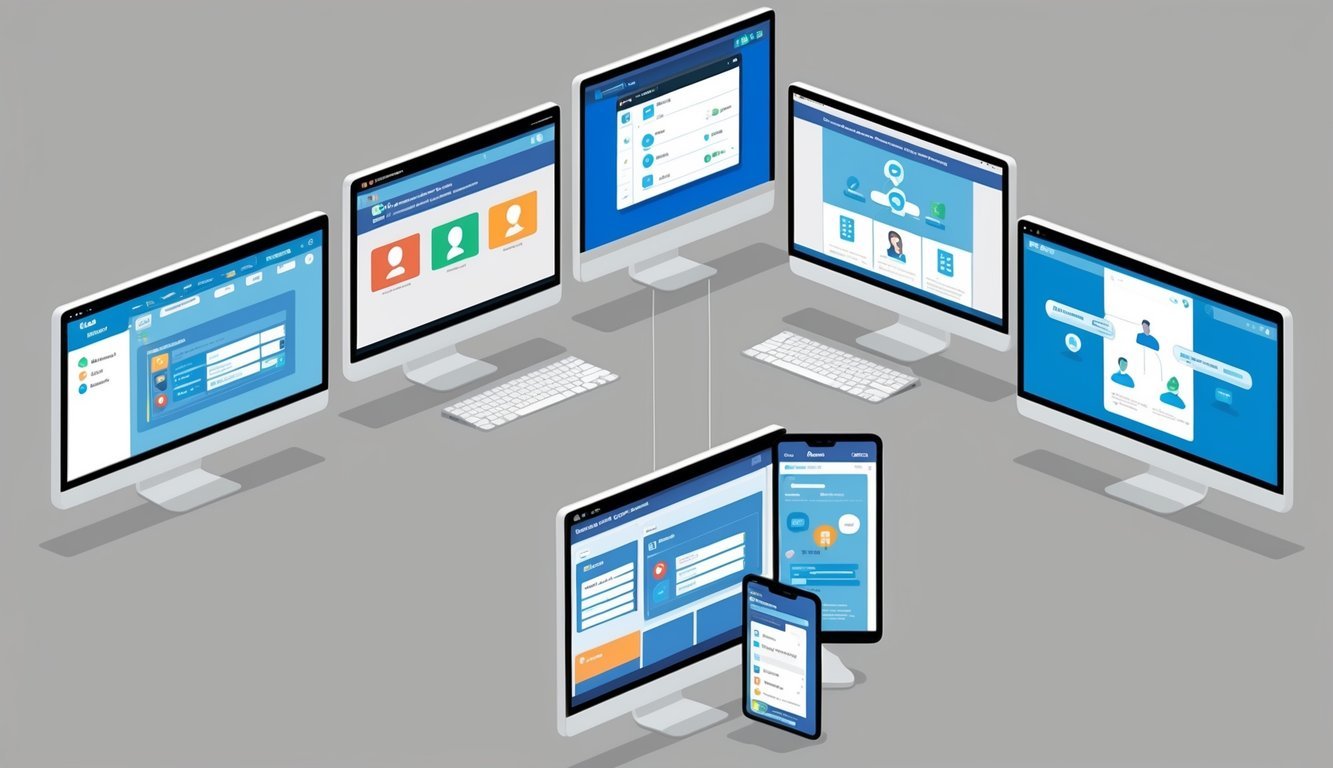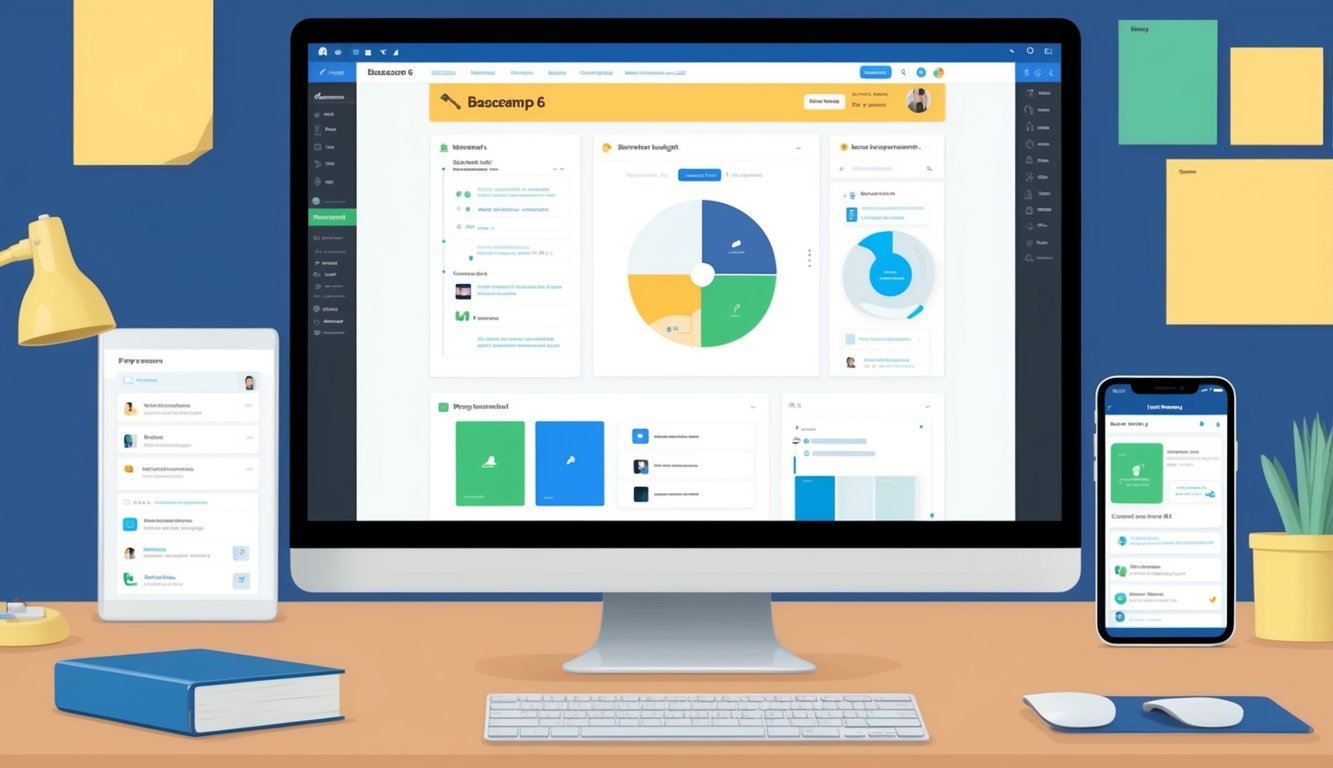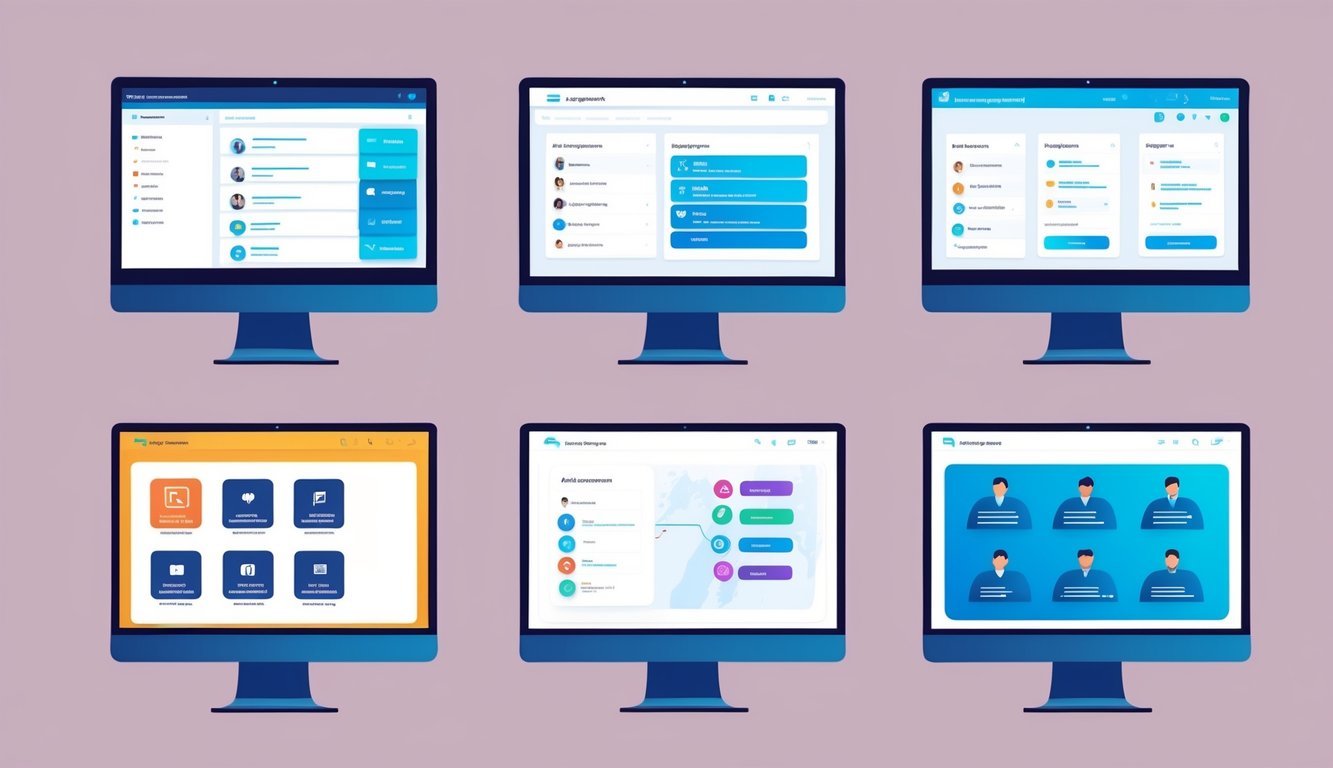Remote work is booming, and let’s be honest—leading a team scattered across different locations can be a real challenge.
You need the right tools to keep everyone connected and productive.
Thankfully, there are some fantastic programs out there that can help you keep your remote team on track.
alt=”A group of six computer screens displaying various remote team management programs in a modern office setting”>
The right remote team management software can supercharge your team’s efficiency and make working from anywhere a breeze. These tools come packed with features like task tracking, video calls, file sharing, and team chats.
With a plethora of options available, you can definitely find one that suits your team’s unique needs.
Let’s dive into some top picks that could really change how you manage your remote crew.
1) Slack
Slack is a go-to tool for remote teams.
Think of it as your virtual office where chatting, file sharing, and collaboration come together.
You can set up different channels for various projects or teams, keeping conversations tidy and easy to follow.
Ever spent ages digging through a cluttered inbox? With Slack, those days are over!
One standout feature is Slack’s Workflow Builder.
It’s fantastic for automating mundane tasks—like setting up welcome messages for new hires or creating custom forms.
The search function is a lifesaver, letting you quickly pull up old messages or files without combing through endless email threads.
Plus, it integrates seamlessly with tons of other apps, allowing you to keep everything you need in one spot.
Need to chat face-to-face? Slack has built-in video calls for those times when you need a little more personal touch—great for catching up or quick meetings.
And guess what? The mobile app ensures you’re always in the loop, even when you’re out and about.
2) Trello
If you’re looking for a slick way to manage your remote team’s projects, Trello is hard to beat.
Imagine a digital bulletin board where you can create cards for tasks and move them around as you progress.
You can set up separate boards for each project or team, keeping everything organized.
Plus, you can tag team members to tasks, which means everyone knows exactly what they need to do.
Trello’s visual layout is helpful for getting an easy overview of all your projects.
It’s like laying out the pieces of a puzzle—instantly spotting which parts need attention.
Ideal for those who thrive on visuals!
Flexibility? You got it! Whether you’re managing simple to-do lists or something more complex, Trello adapts to your needs.
And whether you’re on a computer or a smartphone, Trello’s there for you.
With features like due dates, checklists, and even some automation, it’s designed to keep everyone on the same wavelength, no matter where they are.
3) Asana
When it comes to managing remote teams, Asana is a solid pick.
It helps everyone stay aligned and chugging towards common goals.
With Asana, you can create tasks and assign them to your teammates.
Setting due dates and tracking progress is a breeze, ensuring nothing slips through the cracks.
The software lets you organize work into projects, and you can view these projects as lists, boards, or timelines.
This flexibility caters to different team members’ work styles—no one-size-fits-all here!
Check out Asana’s communication features.
Comment, converse, and share files directly within tasks, cutting down endless email chains.
Plus, Asana plays nice with other tools you’re likely already using, like Slack, Google Drive, and Zoom.
You can stick with your favorites while adding the power of Asana to the mix.
Asana’s got a free plan for smaller teams too, plus paid plans starting at $10.99 per user per month when billed annually, offering even more features.
4) Zoom

Zoom has become a staple for remote team communication.
Sure, you know it for video calls, but it does so much more.
Want to chat with your entire team at once? Zoom’s got you covered with group video meetings.
You can see everyone’s faces, making it feel a bit like you’re all together in the same room.
And there’s more! You can also share your screen, which is super handy when you need to demonstrate a presentation or guide someone through a process.
Concerned about security? Zoom lets you password-protect meetings, ensuring that only invited folks can join the conversation.
If you miss a meeting, don’t sweat it! Zoom can record your calls, making it like having a rewind button for meetings.
Looking to host larger events? Zoom’s webinar feature is ideal for virtual conferences or training sessions for your entire crew.
5) Monday.com

Check out Monday.com—a powerful tool for managing remote teams.
It’s a cloud-based platform designed to keep everyone in sync, no matter where they are.
Monday.com makes it easy to set goals, track progress, and improve communication.
Think of it as a virtual office where everyone gets visibility into what’s going on.
One of the coolest features? You can customize workflows to fit your team’s specific needs.
Assign tasks, set deadlines, and quickly see who’s handling what.
The visual aspect is also a game-changer.
Use colorful boards and charts to make project management a bit more engaging—even enjoyable!
And it plays well with existing tools, like Slack and Google Drive.
This means you don’t have to jump between apps all the time.
Plus, Monday.com has features for time tracking and workload management—perfect for keeping your remote team productive and balanced.
6) Basecamp

Basecamp has been a favorite for managing remote teams since it launched over 20 years ago.
They really know their stuff when it comes to remote work!
With Basecamp, you get all the tools you need in one spot—chat, file sharing, and task tracking, all bundled together.
The user-friendly interface means anyone can figure it out without a tech degree, which is perfect for teams of all sizes and skill levels.
One standout feature is the auto check-ins.
You can set up questions for your team to answer regularly, keeping everyone in the loop without the need for endless meetings.
Oh, and Basecamp also offers valuable resources for remote work.
They even wrote a book on it, sharing tips from their experiences.
Pricing is straightforward—one fee gets you access to everything, so you can skip the hassle of complicated pricing plans.
Benefits of Remote Team Management Tools

Remote team management tools pack plenty of benefits for businesses, making work easier and helping teams get more done.
Increased Flexibility
With these tools, you can work from just about anywhere.
No more being chained to a desk! Video conferencing apps let you jump into meetings from home or a café.
File-sharing systems grant access to your work documents on any device, making it easy to keep track of projects, even if you’re on public transport.
Team chat apps keep you connected throughout the day.
Quick questions and idea sharing can happen anytime, which helps balance work and life seamlessly.
Improved Productivity
Remote tools can really ramp up your team’s productivity. Project management software keeps track of tasks and deadlines, helping you stay on top of what needs doing next.
Time tracking apps show where your hours go, which is invaluable when it comes to refining processes.
Online whiteboards make brainstorming fun and efficient, allowing teams to share ideas visually, even when they’re miles apart.
Shared calendars eliminate the back-and-forth when scheduling meetings, allowing you to focus on what really matters.
Key Features to Look For

When picking remote team management software, focus on the tools that enhance teamwork and keep everyone on track.
The right features can make a huge impact on how your team collaborates from afar.
Collaboration Capabilities
Check for software with real-time communication tools.
You want easy chat, video calls, and file-sharing options.
Think about how you can have team members communicating like they’re in the same room.
It’s a great idea to select a program that enables shared workspaces, so everyone can see and update projects together.
It’s like having a virtual office where all your work lives.
Don’t overlook task assignments and progress tracking.
Good software allows you to delegate tasks clearly, and you can see how they’re going.
This fosters accountability and ensures everyone knows their responsibilities.
Plus, using a platform with the best data privacy features helps secure sensitive information, keeping your projects protected.
Time Management Tools
Time tracking features are crucial.
They give insight into the duration of tasks and where your team is spending its time.
Such information is gold when planning and identifying bottlenecks.
Look for calendars that sync across the team.
When everyone’s aware of each other’s schedules, coordinating meetings and deadlines becomes much easier.
Task prioritization tools? Oh yes! They help you and your team figure out what needs immediate attention.
This keeps everyone focused on what truly matters.
Frequently Asked Questions

Remote teams often lean on various tools to stay connected and productive.
The right software can significantly impact how well they collaborate.
What tools do remote teams use to stay organized and connected?
Teams love using Slack for quick chats and sharing files. Trello is great for tracking tasks and managing projects visually.
For video calls, Zoom is a crowd favorite.
How do you keep a remote team engaged and productive?
Regular check-ins and clear goals keep teams on track. Asana can help you set and monitor team objectives.
Don’t forget about virtual team-building activities or casual video hangouts to boost morale!
What’s better for project management with a remote team: Asana, Trello, or something else?
It really depends on your team’s specific needs. Asana shines for complex projects, while Trello is perfect for visual thinkers.
If you want a bit of both, Monday.com might just be your best bet.
Can you recommend any free programs for managing remote teams effectively?
Trello has a solid free plan that works well for smaller teams. Slack offers a free version with basic features.
And guess what? Zoom lets you have free 40-minute video calls!
What features should you look for in remote team management software?
Be on the lookout for task tracking, file sharing, and communication capabilities.
Time tracking and reporting features come in handy too.
And make sure the software is user-friendly and accessible on different devices!
How can remote team management software improve communication and collaboration?
Good software keeps everyone in the loop.
It allows team members to share updates quickly.
You’ll see who’s working on what and the status of tasks.
This minimizes misunderstandings and keeps projects moving along smoothly.

